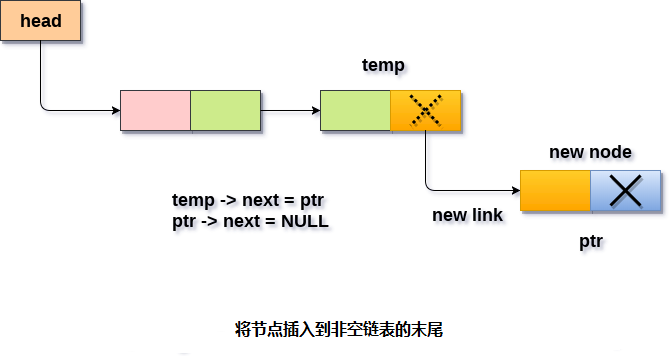要在单链表的最后插入节点,需要提及以下两种情况。
- 新节点添加到空链表中
- 新节点添加到链表的末尾
1. 新节点添加到空链表中
如果满足条件(head == NULL)。 因此,只需要在C语言中使用malloc语句为新节点分配空间。数据和节点的链接部分通过使用以下语句来设置。
ptr->data = item;
ptr -> next = NULL;
因为,ptr是插入链表中的唯一节点,因此需要使链表的头指针指向这个新节点,通过使用以下语句来完成。
Head = ptr
2. 新节点添加到链表的末尾
如果条件head = NULL失败,因为head不为null。需要声明一个临时指针temp才能遍历链表。temp指向链表的第一个节点。
temp = head
然后,使用以下语句遍历整个链表:
while (temp -> next != NULL){
temp = temp -> next;
}
在循环结束时,temp将指向链表的最后一个节点。 现在,为新节点分配空间,并将项目分配给其数据部分。 因为,新节点将成为链表的最后一个节点,因此新节点下一链接部分需要指向null。 使temp节点的下一链接部分(当前是链表的最后一个节点)指向新节点(ptr)。
temp = head;
while (temp -> next != NULL)
{
temp = temp -> next;
}
temp->next = ptr;
ptr->next = NULL;
算法
第1步:IF PTR = NULL
写OVERFLOW
转到第1步
[结束]
第2步:设置NEW_NODE = PTR
第3步:SET PTR = PTR - > NEXT
第4步:设置NEW_NODE - > DATA = VAL
第5步:设置NEW_NODE - > NEXT = NULL
第6步:设置PTR = HEAD
第7步:重复第8步,同时PTR - > NEXT != NULL
第8步:SET PTR = PTR - > NEXT
[循环结束]
第9步:SET PTR - > NEXT = NEW_NODE
第10步:退出

C语言示例代码 -
#include<stdio.h>
#include<stdlib.h>
void lastinsert(int);
struct node
{
int data;
struct node *next;
};
struct node *head;
void main()
{
int choice, item;
do
{
printf("\nEnter the item which you want to insert?\n");
scanf("%d", &item);
lastinsert(item);
printf("\nPress 0 to insert more ?\n");
scanf("%d", &choice);
} while (choice == 0);
}
void lastinsert(int item)
{
struct node *ptr = (struct node*)malloc(sizeof(struct node));
struct node *temp;
if (ptr == NULL)
{
printf("\nOVERFLOW");
}
else
{
ptr->data = item;
if (head == NULL)
{
ptr->next = NULL;
head = ptr;
printf("\nNode inserted");
}
else
{
temp = head;
while (temp->next != NULL)
{
temp = temp->next;
}
temp->next = ptr;
ptr->next = NULL;
printf("\nNode inserted");
}
}
}
执行上面代码,得到类似下面的结果 -
Enter the item which you want to insert?
12
Node inserted
Press 0 to insert more ?
0
Enter the item which you want to insert?
23
Node inserted
Press 0 to insert more ?
2
